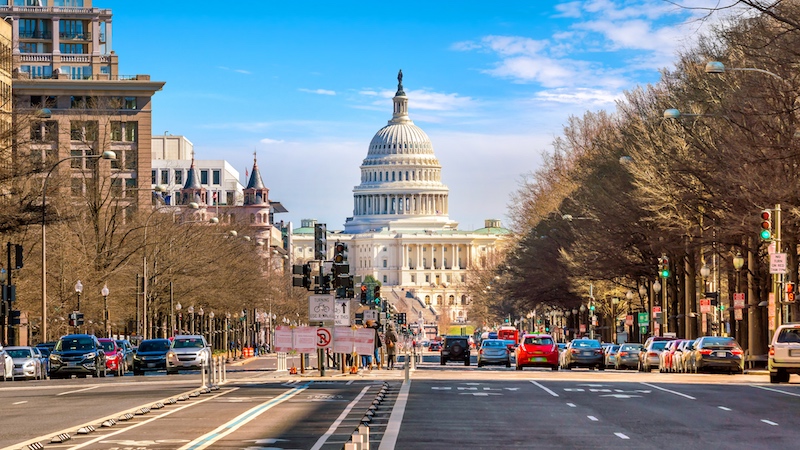
President Trump’s deregulation efforts have resulted in fewer career experts at regulatory agencies.
The Trump Administration’s deregulatory zeal invariably invites comparison with previous eras of deregulation—especially with the Reagan years.
But to understand the present moment completely, we need to go back first to the Pendleton Act of 1883 and the political thought of President Woodrow Wilson, and then, moving forward, to the frustrations experienced in the mid-20th Century by subsequent Presidents from Franklin D. Roosevelt to Richard Nixon.
What these two time periods—late 19th and mid-20th Centuries—highlight are progressive efforts to take politics out of administration and presidential efforts to bring politics—and responsiveness—back in. It is only within this context that both Reagan’s and Trump’s deregulatory efforts can be understood.
The Pendleton Act of 1883 was an attempt to limit the spoils system popularized by President Andrew Jackson and to create a more merit-based, technocratically proficient, professional, and competent civil service. This statute was undergirded by the political thought of President Wilson, who believed that politics could be separated from administration and that bureaucrats could be entrusted to use their expertise and technocratic know-how to make efficient decisions.
But Presidents from Roosevelt to Nixon chafed under this system because they wanted bureaucratic policy to reflect their policy preferences, not those of technocrats.
These tensions led President Roosevelt to complain in colorful language about the difficulty of redirecting federal agencies. Similar frustrations ultimately led President Nixon, in his second term, to develop a new strategic solution.
This strategy has come to be known as the administrative presidency. Developed by Nixon and deployed by other Presidents since, it is a strategy designed to make bureaucratic policymakers more responsive to their elected boss in the White House. At its core, the administrative presidency uses large numbers of politically loyal and like-minded appointees and a robust Office of Information and Regulatory Affairs (OIRA) within the Office of Management and Budget (OMB) to ensure that agencies’ policies reflect presidential preferences.
President Reagan employed this strategy to rescind or revoke numerous Carter-era regulations and to stymie the adoption of new regulations.
Most importantly, Reagan increased the number of appointees serving in federal agencies and issued two executive orders—Executive Order 12,291 and Executive Order 12,498—designed to beef up OIRA’s powers to review agencies’ proposed and final rules.
But President Reagan was constrained by two factors: a Democratically controlled Congress that exercised its oversight function actively and energetically, and a federal judiciary that upheld the Administrative Procedure Act (APA) doctrine prohibiting federal agencies from regulating—or deregulating—“arbitrarily or capriciously.”
For example, Congress’s active oversight of the U.S. Environmental Protection Agency (EPA) led to the resignation of Reagan’s first EPA administrator and a perjury conviction for one of her deputies. Their replacement with appointees more acceptable to Congress slowed EPA’s deregulatory agenda considerably.
On the judicial side, the U.S. Supreme Court was fairly consistent in applying the APA’s “arbitrary and capricious” standard to agency rulemaking—including to decisions to rescind extant rules.
For example, in Motor Vehicle Manufacturers Association v. State Farm Insurance, the Supreme Court held that the National Highway Traffic Safety Administration had acted arbitrarily and capriciously when it rescinded a Carter-era regulation that would have required new automobiles to come equipped with passive restraints, such as air bags. Thus, the Court’s interpretation of the APA also constrained President Reagan’s deregulatory efforts.
In short, President Reagan and his appointees made myriad attempts to deregulate but were frequently stymied by Congress and the courts. Nonetheless, his presidency firmly established the routine use of presidential appointment power and OIRA review, both to ensure agency responsiveness and to tame the bureaucracy—in other words, to put politics back into regulatory decision-making.
Two things that make the current Administration distinct from the Reagan Administration are President Trump’s more explicit disregard for bureaucratic expertise and his increasingly savvy use of his appointment power.
In contrast to President Reagan’s replacement appointees, President Trump’s latest appointees, such as Andrew Wheeler at EPA and David Bernhardt at the Department of Interior, seem to be more committed—and better equipped—to deregulate than their predecessors. And President Trump’s appointees have been even more proactive in their efforts to sideline career experts than President Reagan’s appointees ever were.
This political reality is why the outcome of the next two years will be so heavily dependent on Congress and the courts. Will the courts continue to require federal agencies to provide the sound evidence and reasoning required by the APA? Will they reject the Trump Administration’s rewriting of President Obama’s Clean Power Plan, fuel economy standards, and Title IX guidance based on the standards laid out in State Farm?
And what about Congress? For the first two years of the Trump Administration, both chambers of Congress were in Republican hands, and control of both branches was unified rather than divided. This alignment led Congress to work in tandem with the Trump Administration’s efforts to deregulate.
In fact, between January and December 2017, Congress used the Congressional Review Act 15 times to overturn regulations that had been issued by the departing Obama Administration. As the minority party, Democrats could not even call oversight hearings, and President Trump’s appointees were easily confirmed. Even with the current Democratic majority in the U.S. House of Representatives, Congress still faces considerable constraints in its ability to affect the President’s deregulatory agenda.
Most obviously, the U.S. Senate remains in Republican hands, thus ensuring that President Trump’s appointees will continue to be confirmed irrespective of their policy views, substantive expertise, or managerial experience.
But House committees, with Democratic majorities and Democratic chairs, can now conduct oversight and hold agencies accountable for their deregulatory actions. In other words, the House of Representatives can—potentially—fulfill President James Madison’s intent that Congress serve as a check on the executive branch, keeping it in its “proper” place.
In the end, what will the legacy of President Trump’s deregulatory efforts be beyond the current Administration? Despite a significant increase in the number of politically loyal appointees during the Reagan years, President Wilson’s vision of a neutrally competent and technocratically expert career civil service survived the 1980s more or less intact.
But civil service turnover has been much higher over the past two years. Who will be left to provide the expertise needed to issue scientifically sound, evidence-based regulations should a future President seek to re-regulate?
The current brain drain of expert careerists from regulatory agencies may be the most significant difference between deregulation then and now.
This essay is part of a five-part series, entitled Deregulation Then and Now.




